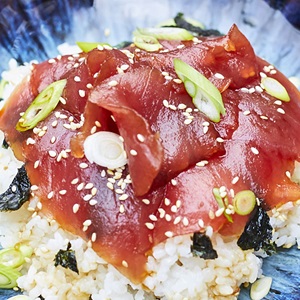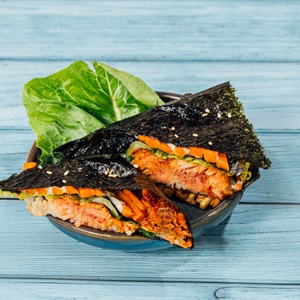What is Tuna?
Tuna is one of the most eaten fish in the world. It belongs to a subgroup of the mackerel family and consists of 8 species that vary in colour and size. Tuna is a nomadic species and is found throughout the world's oceans. It can be eaten fresh or canned. Tuna loin is commonly eaten raw or seared and lightly seasoned, while canned tuna is precooked for a long time and often served heavily dressed.
Choose the right tuna for your dish
The most-sold type of tuna around the world is skipjack, as it is the most abundant tuna in the ocean, making up 60% of the global tuna catch. If you’re in Europe or Asia, skipjack is the tuna species most likely found in tins. 50% of skipjack tuna stocks are found in the Western Central South Pacific Ocean.
As well as skipjack there are four other main species of tuna include albacore, bigeye, bluefin and yellowfin. As with varieties of veg or breeds of cattle, different tuna have different qualities, so choose the right tuna fish for your dish.
The five main species of tuna
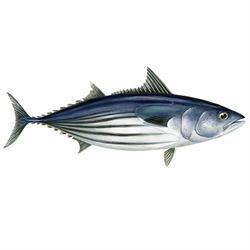
Latin name: Katsuwonus pelamis
Maximum weight: 35 kg
Distinguishing features: Not actually part of the Thunnus genus but is a related species.
Superpower: It has the fastest reproduction rate and the largest stocks of all tuna.
Use: Canned/tinned
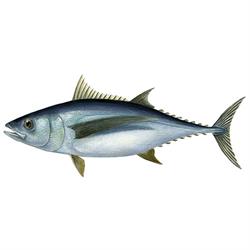
Latin name: Thunnus alalonga
Maximum weight: 60 kg
Distinguishing features: Long pectoral fins.
Superpower: Has a high protein
diet: eats only octopus and squid.
Use: Fresh and in cans. Albacore preserved in olive oil is delicious in salads.

Latin name: Thunnus albacares
Maximum weight: 175 kg
Distinguishing features: Bright yellow fins and finlets.
Superpower: In the East Pacific, near the west coast of Central America, yellowfin tuna and dolphins hang out together. Schools of tuna swim around 100 to 150 metres beneath schools of dolphins. The reasons for this are not entirely understood.
Use: Fresh, canned/tinned. Yellowfin’s mild flavour makes it great in steak form.
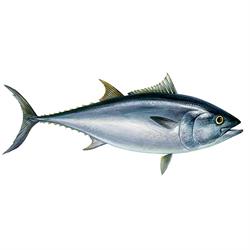
Latin names: Atlantic Bluefin tuna, Thunnus thynnus; Pacific bluefin tuna, Thunnus orientalis; Southern bluefin tuna, Thunnus maccoyii
Maximum weight: 700 kg
Distinguishing features: The giant among tuna. However, it grows very slowly and doesn’t reproduce until it has reached an advanced age.
Superpower: It’s as large and fast as a small car.
Use: Sashimi/sushi
As of 2021, there are only two bluefin tuna fisheries to have met the rigorous sustainable fishing standard set by the MSC, and their catch is only available in Japan and France.
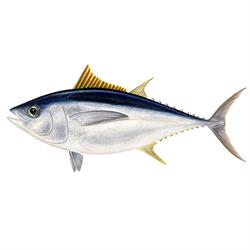
Latin name: Thunnus obesus
Maximum weight: 210 kg
Distinguishing features: Big eyes.
Superpower: Diurnal vertical migrant: over the
course of a day, it can traverse depths ranging by up to 500 metres. The fat layer formed to protect it from cold keeps its flesh juicy.
Use: Sashimi, "white beef"
Is tuna sustainable?
Tuna carrying the blue MSC label is certified sustainable. MSC labelled tuna comes from a fishery that has been independently assessed to the MSC Fisheries Standard. Every supply chain business handling MSC seafood must meet the MSC Chain of Custody Standard, which ensures that fish and seafood sold with the blue label has come from fishing certified as sustainable against the MSC Fisheries Standard.
Tuna is most commonly canned but loins can also be purchased fresh or frozen. Canned, fresh and frozen MSC labelled tuna products can be found throughout the world.
50% of the world’s tuna is engaged in the MSC’s sustainable fishing program
Of the 5.8 million tons of tuna caught, 28.9% is from a fishery that is already MSC certified and a fifth (20.4%) is currently being tested to the MSC Standard. Another fifth of the global tuna catch is from fisheries working on improvements required
to seek certification (19.54% in a fisheries improvement project). The science-based MSC certification scheme checks tuna stocks are healthy and are being managed well, and that the fishery has minimised its impact on the ecosystem. That includes
measures to minimise interactions with other marine species, such as dolphins, turtles and seabirds. To be sure the tuna in your sandwich is from a fishery that has passed these wide-ranging tests, look out for the little blue label on pack, in store
or on the menu.
Bonus facts
- Tuna is an extremely large fish. The biggest tuna catch to date was in Aulds Cove off Nova Scotia by Ken Fraser in 1979. It was an Atlantic bluefin, at the record weight and length of 679kg (1,497lb) and 3.7m (12ft). That’s almost as heavy as a truck!
- All the tuna we eat is caught wild from the ocean. Tuna are carnivores at the top of the food chain, so it is vital to look after the whole ocean ecosystem. For a tuna to gain 1 kilo requires roughly 10 kgs of mid-size fish, 100 kilos of small fish, 1000 kilos of small plant eaters (herbivores such as zooplankton) and 10000 kilograms of phytoplankton.
- Tuna is a global commodity, accounting for more than 8% global seafood trade. By 2027, the canned tuna market could be valued at as much as $US 11.89 bn.
- Tropical skipjack can reproduce from about 2 years old and an adult female can spawn as many as 2million eggs daily, and any time of year. Once fertilised, the tiny eggs hatch within a day, floating on the ocean currents as zooplankton. Tuna in cooler waters have a longer lifecycle, for example, albacore tuna in the Indian Ocean, are usually 5-6 years old before reproducing, spawning every 2.2 days from November to January with females releasing as many as 2.6million eggs.
Tuna recipes
Everything about tuna
Visit our hub for tuna recipes, stories, questions and answers.







